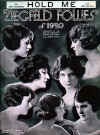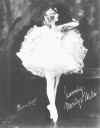Ziegfeld 101
Florenz Ziegfeld: Bio - Part III
by John Kenrick
(Copyright 2002-2004)
(All the photos on this page are thumbnail images – click on them to see larger versions.)
Midnight Frolics
 An
ad for the Midnight Frolic, with a cartoon Will Rogers lassoing the copy.
An
ad for the Midnight Frolic, with a cartoon Will Rogers lassoing the copy.
Ziegfeld got tired of seeing his audiences head out after performances to spend money at other people's nightclubs, so he staged a second late-night revue in The New Amsterdam Theater's underused 680 seat roof top theater. After using it as a dance club in 1914, he decided to create a late night Follies-quality revue. Joseph Urban designed a mechanized stage that could roll back to reveal a dance floor, as well as a glass walkway that would allow chorus girls to dance right over customers' heads.
Click here to see a Frolic promo
depicting the glass walkway.
(This is a large image, so you may need to
be patient with the download.)
In another number, the Frolics chorines encouraged men in the audience to use their cigars to pop the balloons covering the girls' costumes. Insisting that theater-goers would have sore hands after applauding for the Follies, Ziegfeld provided little wooden hammers at the Frolic tables so they could bang out their appreciation. To keep out the rougher elements, Ziegfeld charged a then-hefty $5.00 cover charge -- his regular well-heeled customers were delighted.
Upper class theater-goers were delighted with the Midnight Frolic's party-like atmosphere, and the revue became an annual event from its inception in 1915. Inventive ensemble dances were choreographed by Ned Wayburn, who went on to direct six editions of the Follies. Established Follies headliners like were featured, alongside newcomers like Will Rogers and Eddie Cantor – who soon went on to stardom.
A changing roster of stars and songs kept audiences coming back to the Frolic week after week. Due to popular demand, Ziegfeld added a Nine O'Clock Frolic for those who preferred earlier bedtimes. However, the prohibition of alcohol in 1918 drew late night revelers to illegal speakeasies. In time, Ziegfeld had to admit defeat, and the Frolics came to an end 1923. Even the presence of popular French singer Maurice Chevalier could not save an attempted revival Frolic in 1928 – times and tastes had changed.
Golden Years
Now at the peak of his career, Ziegfeld was something of a living legend. When working on a new production, his day began at 6:00 AM, making business calls before he even got out of bed. Press agents, designers, actors and writers never knew when Broadway's most famous producer might ring them up. Theatre people rarely do business before 10:00 AM, so Ziegfeld drove many co-workers into a rage with such tactics. But it was an effective way to catch people off their guard. And anyone who wanted to work with him had to tolerate such unorthodox habits.
In 1918, two major new stars became part of the Follies family –
- W.C Fields expanded his comic juggling act into the colorful persona that later made him a major Hollywood star. He appeared in several editions of the Follies, burying his personal dislike of Ziegfeld for the sake of a generous contract.
- Although forgotten today, dancer Marilyn Miller was the most acclaimed musical comedy star of the 1920s. Discovered by the Shuberts for their Passing Show revues, Ziegfeld featured Miller in the 1918 and 1919 Follies before deciding to build book musicals around her special talents. This resulted in two of the biggest hits of the 1920s.
The Roaring 20s
 This
sheet music cover from the 1920 Follies is adorned with photos of what we
assume are seven Ziegfeld chorus girls. Their names lost in time, the
legend of the "Ziegfeld Girl" remains a part of the Western world's
common cultural memory.
This
sheet music cover from the 1920 Follies is adorned with photos of what we
assume are seven Ziegfeld chorus girls. Their names lost in time, the
legend of the "Ziegfeld Girl" remains a part of the Western world's
common cultural memory.
As the Jazz Age of the 1920s came roaring up to speed, Ziegfeld was only too happy to provide well-heeled theatergoers with the best entertainment money could buy. Keeping the Follies at the New Amsterdam, he decided to build a theater of his own. Designed by Joseph Urban, The Ziegfeld Theater opened in 1927 and was immediately acclaimed as the handsomest venue in New York. With a unique egg-shaped auditorium and elegant facade, it was the ultimate art deco showplace. This gorgeous theater was demolished in the 1960s to make way for a skyscraper. (The current "Ziegfeld Theatre" is a movie house built on part of the original theater's location.)
The Follies enjoyed longer runs than ever, with 541 performances for the 1922 edition, and 520 in 1924. At a time when the average Broadway musical was budgeted at $25,000, Ziegfeld spent $170,000 on his beloved revue. However, critics were complaining that the series was suffering an artistic decline. The Follies scores had never been great ' most of the hit tunes used in the series came from vaudeville. When the lavish 1926 edition had nothing to offer beyond its sets and costumes, Ziegfeld renamed it No Foolin' so it would not shame the series. But if the Follies were not all they once were, the musicals Ziegfeld now focused on were among of the most important shows of their time.
Sally and Other Hits
 Marilyn
Miller in Sally, a long-running hit
produced by her sometime lover, Ziegfeld.
Marilyn
Miller in Sally, a long-running hit
produced by her sometime lover, Ziegfeld.
Ziegfeld spared no expense in producing Marilyn Miller's first – and greatest – starring vehicle. In fact, in one of the biggest gambles of his career, he bankrolled the record-setting $250,000 production himself. Aside from his justifiable faith in her talents, he was in the midst of a passionate affair with her. After several years of marriage, wife Billie Burke had long since learned to grudgingly permit Ziegfeld such dalliances – it was an old habit he would never break.
Sally (1920 - 570 perfs.) was the story of a dishwasher who's dancing talents (and ability to masquerade as a socialite) lead her to stardom in the Follies. The Jerome Kern score included "Look for the Silver Lining," which Miller delivered to great effect. The show ran for 570 performances and toured for over a year, winning nationwide acclaim. But this success only fed Miller's fiery temper. She tormented Ziegfeld at almost every opportunity, even unexpectedly marrying Jack Pickford (a man her boss despised) to publicly spite him.
After several failures in the middle of the decade led to speculation that he was losing his touch, Ziegfeld came back with a spectacular streak of concurrent hits –
- Rio Rita (1927 - 494 performances) This unlikely hit was the story of a Texas Ranger who chases a bank robber into Mexico, only to fall in love with the lovely Rita. This was the first show to play the Ziegfeld Theater.
- The Three Musketeers (1928 - 319 performances) Matinee idol Dennis King starred as D'Artagnan in this lavish Rudolph Friml operetta based on the Dumas classic.
- Rosalie (1928 - 327 performances) starred Marilyn Miller as princess who cannot marry the West Point cadet she loves – until her father is overthrown in a revolution. The operetta-style score had songs by Sigmund Romberg and the Gershwins, including the classic "How Long Has This Been Going On?"
- Whoopee (1928 - 407 performances) Eddie Cantor won raves as a hypochondriac caught up in romantic intrigue in the Wild West. Ruth Etting stopped the show with "Love Me or Leave Me," and Cantor did the same with the song that became his signature tune – "Makin' Whoopee."
Amid all these musical comedies and operettas, Ziegfeld produced a serious book musical which remains one of the most beloved in the theatrical canon. As with all of Ziegfeld's best shows, it was a tremendous gamble.
